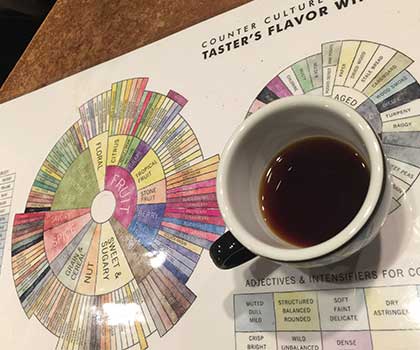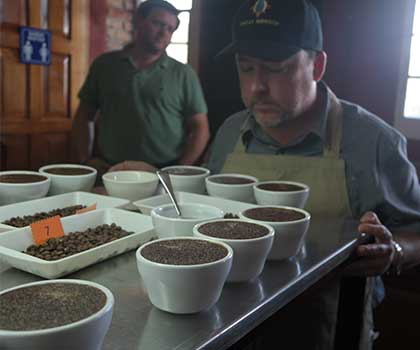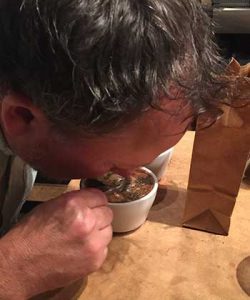What is Coffee Cupping?
Coffee Cupping Ensures Quality
What is coffee cupping? How can coffee cupping ensure quality? Simply put, coffee cupping uses a specific ratio of coffee to water that allows for accurate assessment of coffee flavor and quality. It is a great way to compare coffees for both the professional buyer and the coffee enthusiast. Used internationally, it is the method for tasting coffee to identify its quality and/or its defects.
We use coffee cupping when selecting beans at origin. Cupping permits our buying team to select the highest quality coffees. Once green coffee arrives at the roastery, we use coffee cupping to ensure quality in the roast level and the beans themselves. It also allows our coffee roasting team, sales staff, café managers and baristas to experience the nuances of the coffees they are preparing and recommending to customers.

When conducting a coffee cupping, you are evaluating nine different attributes.
Fragrance/Aroma: The fragrance of the coffee when fresh ground, but still dry. The aroma smell of the coffee when it is first infused with water and when you break the crust of grounds that forms while it steeps.
Flavor: The score given for flavor should take intensity, quality and complexity, combined with aroma experience when the coffee is slurped into the mouth.
Aftertaste: The length of positive flavor qualities after the coffee is expectorated or swallowed. If the aftertaste is unpleasant or short, that lowers the score.
Acidity: Sometimes labeled as “brightness” when pleasant or “sour” when unpleasant, acidity adds to a coffee’s sweetness and fresh-fruit quality. It is most easily identified when first slurped into the mouth.
Body: The tactile feeling of the coffee in the mouth—the feel on both the tongue and the palate.
Balance: The way all the flavor aspects work together to add or detract from the overall flavor experience.
Clean Cup: This refers to lack of any interfering negative aspects from first impression to final aftertaste.
Sweetness: The pleasing fullness of flavor as well as any obvious sweetness and is the result of the carbohydrates present in the sample.
The overall score reflects the whole cup as the cupper perceives it.
How to prepare a coffee cupping
Consistency is incredibly important when coffee cupping. The optimum ratio is 8.25 g of coffee per 150 ml water. Materials you will need:
- coarse coffee grinds of each coffee (13 grams of ground coffee)
- cupping bowls to hold the coffees (our standard cupping bowls hold 250 ml of water)

- water
- a kettle for heating water
- spoons
- cups for spitting the coffees
- paper and pen for your tasting notes
The coffee cupping process uses infusion brewing
Here are the first steps:
- Coarsely grind coffee prior to cupping and carefully measure it into your cupping bowl.
(Before grinding a new sample, run a cleansing quantity through your grinder to ensure the coffee is a single rather than mixed sample.)
- Evaluate the fragrance of the dry samples and make notes in your journal.
- Pour 200⁰ F water directly onto the ground coffee and fill to the rim of the cup.
- Allow the grounds to steep undisturbed for 4 minutes. Evaluate aromas and make notes as the coffees steep.
A crust forms on the top of each cupping bowl and is left until the steep time is over. Then you proceed with full evaluation by following these steps:
 At 4 minutes, use the spoon to break the crust by stirring 3 times, then allowing the foam to run down the back of the spoon while you take in the aroma. Finish your aroma notes at this time.
At 4 minutes, use the spoon to break the crust by stirring 3 times, then allowing the foam to run down the back of the spoon while you take in the aroma. Finish your aroma notes at this time.
When the samples have cooled to 160⁰ F (about 10 – 12 minutes after water infusion), evaluation of the coffee, which is called liquor at this point, can happen.The liquor slurped into the mouth with as much aspiration as possible. This method allows the liquor to cover as much of the tongue and upper palate as possible.
Different flavor attributes of the coffee are evaluated as the coffee cools and are outlined below. A total of three passes should happen: hot (160⁰ F), warm (160-140⁰ F) and room temp (140-70⁰ F).
Evaluation should stop when temperature reaches 70⁰ F. Remember, as you evaluate each attribute, make notes in your journal.
The chart below outlines what elements you evaluate and at what temperatures you will attend to those attributes.
| Attribute | When to Evaluate | Temperature if Applicable | |
| Fragrance/Aroma | Fresh dry grinds/
During steep & crust break |
n/a
200-160⁰ F |
|
| Flavor | 1st Pass | 160⁰ F | |
| Aftertaste | 1st Pass | 160⁰ F | |
| Acidity | 2nd Pass | 160-140⁰ F | |
| Body | 2nd Pass | 160-140⁰ F | |
| Balance | 2nd Pass | 160-140⁰ F | |
| Clean Cup | 3rd Pass | 160-140⁰ F | |
| Sweetness | 3rd Pass | 140-70⁰ F | |
| Overall | 3rd Pass | 140-70⁰ F | |
For more detailed information about coffee cupping, Café Imports and SCAA provide further details and standards for your reference.
Cup of Excellence Cupping Evaluation

